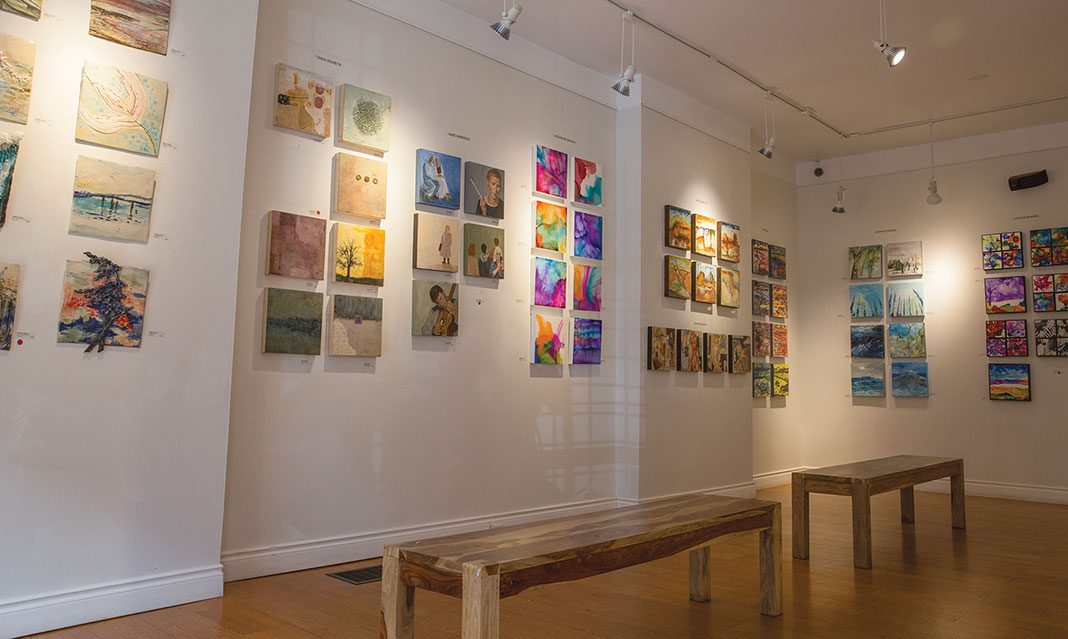After walking through the doors of the Art Square Gallery—a two-part setting comprised of a gallery and a quaint backroom café—I begin to think I’ve made a mistake. I expect to see rows of neatly lined artworks, comprising the exhibition entitled the Square Foot Project, hanging on the white walls. Instead, I see a haphazard collection of art pieces strewn on the floor. A cadre of artists hammer 12-by-12 frames into walls, balance on ladders, and direct one another. It turns out that the opening reception date of the gallery, August 28, was advertised incorrectly.
Despite the confusion surrounding the opening date, I wander freely and acquaint myself with the makeshift exhibit. The exhibition hosts over 200 works by the Art Gala Forum—a non-profit group of twelve artists—in collaboration with seventeen guest artists. The witty exhibition title references the sole artistic restriction of the collection: works must be limited to a twelve-by-twelve sizing. Besides this lone qualification, the creative process is left to the artist. Indeed, my cursory observation takes note of the diverse artistic styles done in ceramic, textile, acrylic, mixed media, sculpture, and more.
A visceral reaction pulls me towards the acrylic works of Connie Gorsline, a fine art guest painter of the exhibit. Gorsline began painting after taking a beginner drawing course at the Art Gallery of Ontario.There, she unearthed a passion for painting in lieu of drawing. Gorsline’s style is abstract, and this style is evidently translated in her works.
When I speak to Gorsline herself about her style, she states that her works are expressive of a kind of “philosophical struggle,” and reflective of her varying moods. Besides some paintings like “Heroically Tall”, which bear recognizable shapes of indistinct trees reaching into a blue sky, the rest of her collection is much more ambivalent in terms of its interpretation.
A grouping of three paintings huddle together on the floor piques my interest. The works are similar in that the principal color in use is blue, transforming the canvases into what I see as oceanic waves. However, each canvas is distinct in the types of hues and gradients of blue employed. “Late Breaking”, for instance, involves cooler tones of blues that remind me of clear skies. Slapped Into Life, on the other hand, uses darker, more intimidating, shades of blues blending into black. The resulting effect being a more turbulent, and ominous vibe exuding from the painting. The last piece in this grouping is “Exhaling Acrylic”. The shades of blue here are midway between its two relatives.
Art Square Gallery features diverse mediums of artwork
Gorsline and I share the same favorite piece: “Slapped Into Life”. For me, the harsh and directionless strokes create a scene a chaos. My first reaction is one of intimidation and fright. For some, the piece induces feelings of melancholia—and I can’t help but agree, given that on another perhaps more somber day, I too might have felt the same. Though Gorsline accepts this response, she underscores her attempt to convey a sense of power, mystery, and brooding. However, I fail to see the conveyance of power; and ultimately, I disagree. I think power requires a degree of control, order, and direction—yet all these aspects were absent in “Slapped Into Life.” Instead, the scene is too chaotic and the image too formless for me to overlook a more overpowering motif of disorder.
A brief walk across the room brings me to the works of Jack Stekelenburg, an abstract metal sculptor who is also a guest artist of the exhibition. Stekelenburg’s chosen medium, metal welding, fascinates me because of its tangible conception: the process of metal welding requires a forge to heat and bend metal into a desired shape.
Stekelenburg’s collection is entitled “Faces”, and its composing pieces stay true to this namesake. Rows of metal frames are shaped into abstract faces. What is notable of this collection is that Stekelenburg, similar to how composers use the same sets of twelve semitones to make diverse music, reused six to eight shapes to produce different facial features. One piece called “Einstein” portrays an oval-shaped face with a group of four circles projecting from the head to represent hair. I like this piece, simply because the artist’s humorous personality shines through—viewing this caricature, with its clear exaggeration of Einstein’s hallmark feature (voluminous hair), draws laughter from me. Another piece called “Paul” is one that I think has the most inviting facial expression among the bunch. I make out a bright smile and kind eyes from “Paul.” This same kind of characteristic is present in all the remaining pieces.
Although seemingly disconnected, all artworks in the Square Foot Projects are united by a single restriction. It requires that the artist must create within a twelve-by-twelve dimension. Though this restriction limits the physical space by which the artists can work with, does it indirectly restrict the creativity found in the collection? I don’t think so. In fact, the diversity of mediums and motifs found in the Square Foot Project are its attraction.
Square Foot Project runs until September 25.



